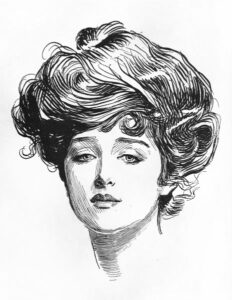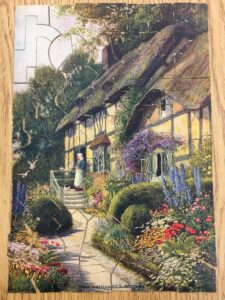Puzzling During a Pandemic: America’s 3rd Puzzle Craze
By Amy Pepe, Visitor Services and Public Programs Manager at Rose Hill Mansion and Johnston House
The coronavirus pandemic triggered shortages of lots of essential items, from toilet paper to meat products. However, we also saw shortages of some not-so essential items. One of the products that has seen the highest surge in demand during the pandemic? Jigsaw puzzles.
Since March of this year, headlines from NPR, Vanity Fair, and the Guardian (to name just a few) declared that puzzles were in such high demand during the pandemic that puzzle manufacturers were struggling to keep up. In some states, the shortage was complicated by the fact that puzzle manufacturers could not operate as they were not considered essential when stricter measures were in place. Puzzle brands Ceaco and Ravensburger both reported an over 300% increase in sales in March 2020 than at the same time last year. The puzzle sections in box stores like Target and Wal-Mart were emptied early on, and at some points during the pandemic, it was nearly impossible to order a jigsaw puzzle online from Amazon. Even ordering directly from smaller puzzle retailers, like Dowdle Folk Arts or White Mountain , could not guarantee in-stock items or timely shipments (I’m still waiting on some that I ordered at the end of April). Some companies are still struggling to catch up to demand, even as restrictions are loosening throughout the country.
So, what is behind this puzzle craze? If you take a look historically, it doesn’t come as a surprise. In fact, the increased demand and shortage of jigsaw puzzles during the pandemic may come to be seen as America’s 3rd puzzle craze. Times of high uncertainty, stress, and unemployment have more than once been a boon for the jigsaw puzzle industry.
The First Puzzle Craze: 1907-1911
Jigsaw puzzles had been slowly growing in popularity as an adult amusement (and not just an educational toy for children) from about the 1870s. The first commercial puzzle “craze” in the United States lasted from 1907-1911. The popularity of jigsaw puzzles increased at a frenzied pace through Boston and the northeast United States. A May 1908 New York Times headline proclaimed “New Puzzle Menaces the City’s Sanity. Young and old, rich and poor, all hard at work fitting cut-up pictures together. Solitaire is forgotten. Two clergymen, a supreme court justice, and a noted financier among the latest converts to the craze.”
Some notable puzzlers during this craze included President Theodore Roosevelt, Czar Nicholas II of Russia, and financier J.P. Morgan. Contrary to the New York Times headline, the poor were not doing puzzles in 1908. Jigsaw puzzles at this time were most accessible to the wealthy, and indeed puzzles became extremely popular among high society as a must-have at vacation homes and house parties. Most puzzles cost 1 cent per piece, or $4 for a 400 piece puzzle at a time when the average American worker earned only $12 a week; they were out of reach for the working class. Some clever answers arose to this problem, such as puzzle rental libraries, shared puzzle clubs, and the “puzzle exchange” in New York City where puzzle owners could trade in for a new one for a small fee.
Puzzles at this time frequently featured images from Japan and Europe, Gibson girls, and courtship scenes as well as fine art illustrations by popular artists.

Example of a Gibson Girl image that could have been used as a puzzle in the 1910s.
The growing obsession with jigsaw puzzles seemed to have something to do with the psychological element; people became immersed in completing the puzzle and it offered a distraction from life’s problems, even though this time period was not marked by exceptionally high unemployment or national stress. As the obsession grew, people demanded increasingly difficult puzzles with trick edges, no cover image, and images on both sides.
Some big name game manufacturers capitalized on the puzzle craze during this period, including Parker Brothers. Parker Brothers produced jigsaw puzzles in a variety of styles including interlocking, non-interlocking, and color-line cutting. Their most important contribution however was the popularization of “figure” pieces; puzzle pieces that looked like recognizable objects.
Though not a brand new idea, Parker Brothers was the first to use figure pieces in commercially successful puzzles. Parker primary employed “pastime girls;” the team of women who cut these intricate and complicated pieces. Parker claimed women were more skilled at cutting these pieces than men because they had smaller hands, but in reality they could pay women lower wages than men for the same work. Women were paid piece work until the federal minimum wage was enforced in 1937 and were expected to cut at least 1400 pieces per day.
This first puzzle craze tapered off in about 1911, without any direct explanation. Though not in such a feverish demand, puzzles maintained a steady popularity throughout the 1910s and 1920s. The jigsaw puzzle craze returned with a vengeance in the 1930s, when Americans were desperate for relief from crushing economic problems.
The Second Puzzle Craze: 1932-1933
Just as movies and the entertainment industry rose to popularity during the Great Depression, so too did jigsaw puzzles provide affordable entertainment to the masses. Completing a jigsaw gave the puzzler a sense of accomplishment that was hard to come by when the unemployment rate was climbing above 25 percent, and much higher in some industries. With incomes depleted, home amusements like puzzles replaced outside entertainment like restaurants and night clubs. Unlike the first puzzle craze, during the 1930s people of all economic backgrounds had access to puzzles.
It’s difficult to overstate the grip jigsaw puzzles had on Americans during the early 1930s. They could be found everywhere: on newsstands, in stores, in films, in newspapers, songs, books, and in living rooms throughout the country.

In June 1932, the Prophylactic Brush Company in Massachusetts offered a free 50-piece puzzle to toothbrush buyers. The promotion was a runaway success, leading to a huge sales increase. Hundreds, if not thousands, of other businesses followed suit and began to give away or include puzzles as incentives to purchase their product.
This time around, puzzles were not only for the wealthy. The switch from wood to cardboard significantly curtailed the cost of puzzles and could be manufactured much more quickly using a standard die-cut instead of being hand cut. A 300 piece puzzle now cost as little as 25 cents. However, this increased access came primarily by way of advertising.
By the end of 1932, over 200 companies were producing die-cut puzzles, most of which were for advertising. By February of 1933, the puzzle industry was producing over 10 million puzzles per week; over 7 million of them were advertising puzzles. Some of the jigsaw puzzle images were in and of themselves advertisements for the company, some featured a pleasing image with the name of the company on it, like the one for the Geneva Baking Company. Still others were double sided.
The autumn of 1932 brought a novel concept, the weekly jigsaw puzzle. The die-cut Jig of the Week retailed for 25 cents and appeared on the newsstands every Wednesday. People rushed to buy them and to be the first among their friends to solve that week’s puzzle. There were dozens of weekly series including Picture Puzzle Weekly, B-Witching Weekly, Jiggers Weekly, and (featuring popular films) Movie Cut-Ups.

Advertising puzzle from the Geneva Baking Company from the 1930s. The box it came in advertised the company, even though the puzzle image is unrelated: “Anne Hathaway’s Cottage” by artist Ernest Haslehust.
In general, puzzle images during the depression were nostalgic, romantic, and exotic, “an antidote for the hard times.” Historical images, seascapes, paintings of cottages and lighthouses were all popular choices. Puzzles could also depict movies stars, political cartoons, and events such as the Chicago World’s Fair, but never alluded to the economic situation.
Interestingly, the puzzle craze slowed down in 1933, pretty much just as prohibition restrictions were loosened, Roosevelt began to repair the economy, and puzzles began to be taxed. As Americans grew more optimistic about the economy and the future, their reliance on jigsaw puzzles as a distraction shrank.
It’s not hard to see the parallels between eagerness for puzzles during the Great Depression and today. It seems that whenever a lot of Americans are unemployed, stuck at home, or in serious need of a distraction and some stress relief, jigsaw puzzles skyrocket in popularity.
While I am always an avid puzzler, I have to admit my to-be-done stack of puzzles dwindled dangerously low the past few months. I’m just happy I received puzzles as birthday gifts in early June, perhaps a sign that the craze is already winding down. Whether or not the craze is here to stay once we’ve returned to our new normal, we can know with some certainty that we will see another jigsaw puzzle craze at some point in the future.

An in-progress look at one of the dozen or so puzzles the author has done during the pandemic
Much of this post is based on the work of Anne D. Williams, Professor Emerita at Bates College in Lewiston, Maine. For more on the history of jigsaw puzzles see her book The Jigsaw Puzzle, Piecing Together A History.
To learn about the origins of jigsaw puzzles, read Amy’s blog article “Dissected Maps.”
Try one of our virtual jigsaw puzzles.

